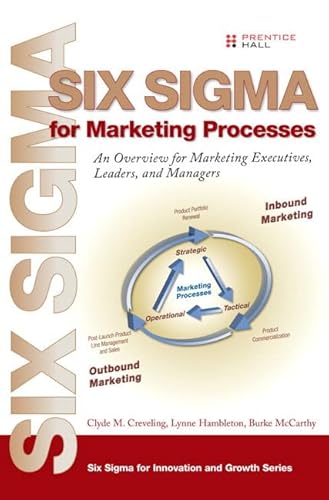Items related to Six Sigma for Marketing Processes: An Overview for...
Six Sigma for Marketing Processes: An Overview for Marketing Executives, Leaders, and Managers (Six Sigma for Innovation and Growth) - Softcover

Synopsis
Nearly half of the top one hundred Fortune 500 companies use Six Sigma methodology in some part of their business. These companies have been among the top one hundred for five or more years and consistently report higher revenue and significantly higher profits than competitors. This underscores the impact on the cost side. Now the focus moves to revenue growth. Six Sigma consultant Clyde M. Creveling’s Design for Six Sigma in Technology and Product Development is the standard guide for product commercialization and manufacturing support engineers who want to apply Six Sigma methodology to technology development and product commercialization. Now, in Six Sigma for Marketing Processes, Creveling joins with Lynne Hambleton and Burke McCarthy to show the ways marketing professionals can adapt and apply those same Six Sigma concepts to create a lean marketing workflow built for growth.
This book provides an overview of the way marketing professionals can utilize the value offered by Six Sigma tools, methods, and best practices, within their existing phase-gate processes, as well as the traditional Six Sigma problem-solving approach: define, measure, analyze, improve, control (DMAIC). It provides unique methods for employing Six Sigma to enhance the three marketing processes for enabling a business to attain growth: strategic, tactical, and operational. It goes further to demonstrate the way Six Sigma for marketing and Six Sigma for design can be combined into a unified Six Sigma for growth. In this book, you’ll learn how to apply Six Sigma methodology to
- Develop a lean, efficient marketing workflow designed for growth
- Enhance the three marketing arenas for growth: strategic, tactical, and operational
- Identify leading indicators of growth and become proactive about performance improvement
- Strengthen links between customers, products, and profitability
- Redesign marketing work to streamline workflow and reduce variability
- Assess and mitigate cycle-time risk in any marketing initiative or project
- Leverage DMAIC to solve specific problems and improve existing processes
- Use lean techniques to streamline repeatable processes, such as collateral development and trade-show participation
Preface xv
Acknowledgments xxiii
About the Authors xxv
Chapter 1: Introduction to Six Sigma for Marketing Processes 1
Chapter 2: Measuring Marketing Performance and Risk Accrual Using Scorecards 25
Chapter 3: Six Sigma-Enabled Project Management in Marketing Processes 45
Chapter 4: Six Sigma in the Strategic Marketing Process 63
Chapter 5: Six Sigma in the Tactical Marketing Process 117
Chapter 6: Six Sigma in the Operational Marketing Process 173
Chapter 7: Quick Review of Traditional DMAIC 209
Chapter 8: Future Trends in Six Sigma and Marketing Processes 229
Glossary 235
Index 261
"synopsis" may belong to another edition of this title.
About the Author
Clyde "Skip" Creveling is the president and founder of Product Development Systems & Solutions Inc. (PDSS) (http://www.pdssinc.com). Since PDSS' founding in 2002, Mr. Creveling has led Design for Six Sigma (DFSS) initiatives at Motorola, Carrier Corporation, StorageTek, Cummins Engine, BD, Mine Safety Appliances, Callaway Golf, and a major pharmaceutical company. Prior to founding PDSS, Mr. Creveling was an independent consultant, DFSS Product Manager, and DFSS Project Manager with Sigma Breakthrough Technologies Inc. (SBTI). During his tenure at SBTI he served as the DFSS Project Manager for 3M, Samsung SDI, Sequa Corp., and Universal Instruments.
Mr. Creveling was employed by Eastman Kodak for 17 years as a product development engineer within the Office Imaging Division. He also spent 18 months as a systems engineer for Heidelberg Digital as a member of the System Engineering Group. During his career at Kodak and Heidelberg he worked in R&D, Product Development/Design/System Engineering, and Manufacturing. Mr. Creveling has five U.S. patents.
He was an assistant professor at Rochester Institute of Technology for four years, developing and teaching undergraduate and graduate courses in mechanical engineering design, product and production system development, concept design, robust design, and tolerance design. Mr. Creveling is also a certified expert in Taguchi Methods.
He has lectured, conducted training, and consulted on product development process improvement, design for Six Sigma methods, technology development for Six Sigma, critical parameter management, robust design, and tolerance design theory and applications in numerous U.S, European, and Asian locations. He has been a guest lecturer at MIT, where he assisted in the development of a graduate course in robust design for the System Design and Management program.
Mr. Creveling is the author or coauthor of several books, including Six Sigma for Technical Processes, Six Sigma for Marketing Processes, Design for Six Sigma in Technology and Product Development, Tolerance Design, and Engineering Methods for Robust Product Design. He is the editorial advisor for Prentice Hall's Six Sigma for Innovation and Growth Series.
Mr. Creveling holds a B.S. in mechanical engineering technology and an M.S. from Rochester Institute of Technology.
"About this title" may belong to another edition of this title.
US$ 3.00 shipping within U.S.A.
Destination, rates & speedsSearch results for Six Sigma for Marketing Processes: An Overview for...
Six Sigma for Marketing Processes: An Overview for Marketing Executives, Leaders, and Managers (Six Sigma for Innovation and Growth)
Seller: Fables Books, Goshen, IN, U.S.A.
Condition: good. A former library book with all the expected stamps, stickers and markings. Excellent condition for a former library book. Spine reinforced with clear tape. Some shelf, storage or usage wear present. The binding is tight and all pages are present. The pages appear unmarked. Pictures available upon request. Individually inspected by Shadow. Thanks for supporting an independent bookseller! Seller Inventory # FBV.0133992500.G
Quantity: 1 available

